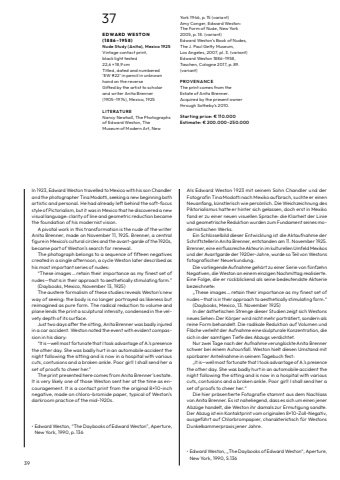Page 41 - Demo
P. 41
3937E D WA R D W E S T O N ( 1 8 8 6 %u2013 1 9 5 8 ) Nude Study (Anita), Mexico 1925Vintage contact print, black light tested 22,6 %u00d7 18,9 cmTitled, dated and numbered %u2018EW #22%u2019 in pencil in unknown hand on the reverse Gifted by the artist to scholar and writer Anita Brenner (1905%u20131974), Mexico, 1925LITERATURENancy Newhall, The Photographs of Edward Weston, The Museum of Modern Art, New York 1946, p. 15 (variant) Amy Conger, Edward Weston: The Form of Nude, New York 2005, p. 18. (variant) Edward Weston%u2019s Book of Nudes, The J. Paul Getty Museum, Los Angeles, 2007, pl. 3. (variant) Edward Weston 1886%u20131958, Taschen, Cologne 2017, p. 89. (variant)PROVENANCEThe print comes from the Estate of Anita Brenner. Acquired by the present owner through Sotheby%u2019s 2010.Starting price: %u20ac 110.000Estimate: %u20ac 200.000%u2013250.000Als Edward Weston 1923 mit seinem Sohn Chandler und der Fotografin Tina Modotti nach Mexiko aufbrach, suchte er einen Neuanfang, k%u00fcnstlerisch wie pers%u00f6nlich. Die Weichzeichnung des Piktorialismus hatte er hinter sich gelassen, doch erst in Mexiko fand er zu einer neuen visuellen Sprache: die Klarheit der Linie und geometrische Reduktion wurden zum Fundament seines modernistischen Werks.Ein Schl%u00fcsselbild dieser Entwicklung ist die Aktaufnahme der Schriftstellerin Anita Brenner, entstanden am 11. November 1925. Brenner, eine einflussreiche Akteurin im kulturellen Umfeld Mexikos und der Avantgarde der 1920er-Jahre, wurde so Teil von Westons fotografischer Neuerkundung.Die vorliegende Aufnahme geh%u00f6rt zu einer Serie von f%u00fcnfzehn Negativen, die Weston an einem einzigen Nachmittag realisierte. Eine Folge, die er r%u00fcckblickend als seine bedeutendste Aktserie bezeichnete:%u201eThese images %u2026 retain their importance as my finest set of nudes%u2014that is in their approach to aesthetically stimulating form.%u201c(Daybooks, Mexico, 13. November 1925)In der %u00e4sthetischen Strenge dieser Studien zeigt sich Westons neues Sehen: Der K%u00f6rper wird nicht mehr portr%u00e4tiert, sondern als reine Form behandelt. Die radikale Reduktion auf Volumen und Fl%u00e4che verleiht der Aufnahme eine skulpturale Konzentration, die sich in der samtigen Tiefe des Abzugs verdichtet.Nur zwei Tage nach der Aufnahme verungl%u00fcckte Anita Brenner schwer bei einem Autounfall. Weston hielt diesen Umstand mit sp%u00fcrbarer Anteilnahme in seinem Tagebuch fest:%u201eIt is%u2014well most fortunate that I took advantage of A.%u2019s presence the other day. She was badly hurt in an automobile accident the night following the sitting and is now in a hospital with various cuts, contusions and a broken ankle. Poor girl! I shall send her a set of proofs to cheer her.%u201cDie hier pr%u00e4sentierte Fotografie stammt aus dem Nachlass von Anita Brenner. Es ist naheliegend, dass es sich um einen jener Abz%u00fcge handelt, die Weston ihr damals zur Ermutigung sandte. Der Abzug ist ein Kontaktprint vom originalen 8%u00d710-Zoll-Negativ, ausgef%u00fchrt auf Chlorbrompapier, charakteristisch f%u00fcr Westons Dunkelkammerpraxis jener Jahre.%u2022 Edward Weston, %u201eThe Daybooks of Edward Weston%u201c, Aperture, New York, 1990, S.136In 1923, Edward Weston travelled to Mexico with his son Chandler and the photographer Tina Modotti, seeking a new beginning both artistic and personal. He had already left behind the soft-focus style of Pictorialism, but it was in Mexico that he discovered a new visual language: clarity of line and geometric reduction became the foundation of his modernist vision.A pivotal work in this transformation is the nude of the writer Anita Brenner, made on November 11, 1925. Brenner, a central figure in Mexico%u2019s cultural circles and the avant-garde of the 1920s, became part of Weston%u2019s search for renewal.The photograph belongs to a sequence of fifteen negatives created in a single afternoon, a cycle Weston later described as his most important series of nudes:%u201cThese images %u2026 retain their importance as my finest set of nudes%u2014that is in their approach to aesthetically stimulating form.%u201d(Daybooks, Mexico, November 13, 1925)The austere formalism of these studies reveals Weston%u2019s new way of seeing: the body is no longer portrayed as likeness but reimagined as pure form. The radical reduction to volume and plane lends the print a sculptural intensity, condensed in the velvety depth of its surface.Just two days after the sitting, Anita Brenner was badly injured in a car accident. Weston noted the event with evident compassion in his diary:%u201cIt is%u2014well most fortunate that I took advantage of A.%u2019s presence the other day. She was badly hurt in an automobile accident the night following the sitting and is now in a hospital with various cuts, contusions and a broken ankle. Poor girl! I shall send her a set of proofs to cheer her.%u201dThe print presented here comes from Anita Brenner%u2019s estate. It is very likely one of those Weston sent her at the time as encouragement. It is a contact print from the original 8%u00d710-inch negative, made on chloro-bromide paper, typical of Weston%u2019s darkroom practice of the mid-1920s.%u2022 Edward Weston, %u201cThe Daybooks of Edward Weston%u201d, Aperture, New York, 1990, p.136


